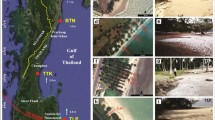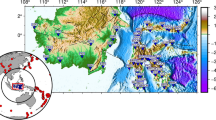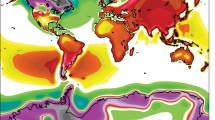Abstract
Data from three bathymetric surveys by R/V Kairei using a 12-kHz multibeam echosounder and differential GPS were used to create an improved topographic model of the Challenger Deep in the southwestern part of the Mariana Trench, which is known as the deepest seafloor in the world. The strike of most of the elongated structures related to plate bending accompanied by subduction of the Pacific plate is N70°E and is not parallel to the trench axis. The bending-related structures were formed by reactivation of seafloor spreading fabric. Challenger Deep consists of three en echelon depressions along the trench axis, each of which is 6–10 km long, about 2 km wide, and deeper than 10,850 m. The eastern depression is the deepest, with a depth of 10,920 ± 5 m.




Similar content being viewed by others
References
Asada A, Yabuki T (2001) Synthetic aperture technique applied to a multi-beam echo sounder. Earth Planets Space 53:321–326
Barry JP, Hashimoto J (2009) Revisiting the Challenger Deep Using the ROV Kaiko. Mar Technol Soc J 43:77–78. doi:10.4031/MTSJ.43.5.27
Bird P (2003) An updated digital model for plate boundaries. Geochem Geophys Geosyst 4. doi:10.1029/2001GC000252
Bowen AD, Yoerger DR, Taylor C, McCabe R, Howland J, Gomez-Ibanez D, Kinsey JC, Heintz M, McDonald G, Peters D, Bailey J, Shank T, Whitcomb LL, Martin SC, Webster SE, Jakuba MV, Young C, Buescher J, Fletcher B, Fryer P, Hulme S (2009) Field trials of the Nereus hybrid underwater robotic vehicle in the Challenger Deep of the Mariana Trench. In Proc IEEE/MTS OCEANS Conf Exhib Biloxi MS Oct 2009. pp 1–10
Caress D, Chayes DN (1996) Improved procession of Hydrosweep DS Multibeam data on the R/V Maurice Ewing. Mar Geophys Res 18:631–650. doi:10.1007/BF00313878
Carruthers JN, Lawford AL (1952) The deepest oceanic sounding. Nature 169:601–603. doi:10.1038/169601a0
Del Grosso VA (1974) New equation for the speed of sound in natural waters (with comparisons to other equations). J Acoust Soc Am 56:084–1091. doi:10.1121/1.1903388
Fisher RL (2009) Meanwhile, Back on the surface: further notes on the sounding of trenches. Mar Technol Soc J 43:16–19. doi:10.4031/MTSJ.43.5.7
Fisher RL, Hess HH (1963) Trenches. In: Hill MN (ed) The Sea, 3. Wiley-Interscience, New York, pp 411–436
Fletcher B, Bowen A, Yoerger DR, Whitcomb LL (2009) Journey to the Challenger Deep: 50 years later with the Nereus hybrid remotely operated vehicle. Mar Technol Soc J 43:65–76. doi:10.4031/MTSJ.43.5.26
Fryer P, Becker N, Appelgate B, Martinez F, Edwards M, Fryer G (2003) Why is the Challenger Deep so deep? Earth Planet Sci Lett 211:259–269
Fujimoto H, Fujiwara T, Kong L (1993) Sea Beam survey over the Challenger Deep revisited. in: Preliminary report of the Hakuho-Maru cruise KH92–1. Ocean Research Institute, the University of Tokyo, Tokyo, pp 26–27
Fujioka K, Okino K, Kanamatsu T (2002) Morphology and origin of the Challenger Deep in the southern Mariana Trench. Geophys Res Lett 29:1372. doi:10.1029/2001GL013595
Gaskell TF, Swallow JC, Ritchie GS (1953) Further notes on the greatest oceanic sounding and the topography of the Marianas Trench. Deep-Sea Res 1:60–63. doi:10.1016/0146-6313(53)90009-4
Gvirtzman Z, Stern RJ (2004) Bathymetry of Mariana trench-arc system and formation of the Challenger Deep as a consequence of weak plate coupling. Tectonics 23:TC2011. doi:10.1029/2003TC001581
Hammerstad E (2001) Multibeam echo sounder accuracy. EM Technical Note, Internal Kongsberg Simrad Publication
Hanson PP, Zenkevich NL, Sergeev UV, Udintsev GB (1959) Maximum depths of the Pacific Ocean. Priroda 6:84–88 (in Russian)
Hashimoto J (1998) Onboard report of KR98–05 cruise in the Challenger Deep. RV KAIREI/ROV KAIKO. JAMSTEC, Yokosuka
Hashimoto J (2002) KR02–13 KAREI/KAIKO cruise in the Challenger Deep. JAMSTEC, Yokosuka
Hydrographic Department, Japan Marine Safety Agency (1984) Mariana Trench survey by the “Takuyo”. Int Hydrogr Bull Spt:351–352
Johnston GT (1994) Comparison of two multi-site reference station differential GPS. J Navig 47:305–322. doi:10.1017/S037346330001225X
Kobayashi K, Nakanishi M, Tamaki K, Ogawa Y (1998) Outer slope faulting associated with western Kuril and Japan trenches. Geophys J Int 134:356–372. doi:10.1046/j.1365-246x.1998.00569.x
Kyo M, Miyazaki E, Tsukioka S, Ochi H, Amitani Y, Tsuchiya T, Aoki T, Takagawa S (1995) The sea trial of Kaiko, the full ocean depth research ROV. OCEANS’95 MTS/IEEE Proceedings. pp 1991–1996. doi:10.1109/OCEANS.1995.528882
Masson DC (1991) Fault patterns at outer trench walls. Mar Geophys Res 13:209–225. doi:10.1007/BF00369150
Miller MS, Gorbatov A, Kennett BLN (2006) Three-dimensional visualization of a near-vertical slab tear beneath the southern Mariana arc. Geochem Geophys Geosyst 7:Q06012. doi:10.1029/2005GC001110
Nakanishi M (2011a) Field evaluation of sounding accuracy in the multi-narrow beam echosounder in deeper than 9,000 m of water depth. J Jpn Soc Mar Sur Techno 23 (in press) (Japanese with English abstract and figure captions)
Nakanishi M (2011b) Bending-related topographic structures of the subducting plate in the northwestern Pacific Ocean. In: Ogawa Y, Anma R, Dilek Y (eds) Accretionary prisms and convergent margin tectonics in the northwest Pacific Basin, modern approaches in solid earth sciences 8. Springer Science+Business Media B.V., Berlin, pp 1–38. doi:10.1007/978-90-481-8885-7_1
Nakanishi M, Tamaki K, Kobayashi K (1992a) Magnetic anomaly lineations from Late Jurassic to Early Cretaceous in the west-central Pacific Ocean. Geophys J Int 109:701–719. doi:10.1111/j.1365-246X.1992.tb00126.x
Nakanishi M, Tamaki K, Kobayashi K (1992b) A new Mesozoic isochron chart of the northwestern Pacific Ocean: Paleomagnetic and tectonic implications. Geophys Res Lett 19:693–696. doi:10.1029/92GL00022
Piccard J, Dietz RS (1961) Seven miles down; The story of the bathyscaph Trieste. GT Putnam’s Sons, New York
Ranero CR, Villasenor A, Phipps Morgan J, Weinrebe W (2005) Relationship between bend-faulting at trenches and intermediate-depth seismicity. Geochem Geophys Geosyst 6:Q12002. doi:10.1029/2005GC000997
Sea-Bird Electronics, Inc (2004) Determination of sound velocity from CTD data. Sea-Bird application Note 6, Sea-Bird Electronics, Inc. http://www.seabird.com/application_notes/AN06.htm. Accessed 6 April 2011
Smith WHF, Sandwell DT (1997) Global sea floor topography from satellite altimetry and ship depth soundings. Science 277:1956–1962. doi:10.1126/science.277.5334.1956
Taira K, Yanagimoto D, Kitagawa S (2005) Deep CTD casts in the Challenger Deep, Mariana Trench. J Oceanogr 61:447–454
Takagawa S, Aoki T, Kawana I (1997) Diving to Mariana Trench by Kaiko. Recent Adv Mar Sci Technol 96:89–96
Tamaki K, Nakanishi M, Oshida A, Sayanagi K (1992) A universal marine geophysics data processing system. Bull Ocean Res Inst, 30. Ocean Research Institute, the University of Tokyo, Tokyo
Thomson CW, Murray J (1895) Report of the scientific results of the voyage of H.M.S. Challenger during the years 1873–76 under the command of Captain Georges S. Nares and the late Captain Frank Tourle Thomson, HM Governement, London
Wessel P, Smith WHF (1998) New, improved version of Generic Mapping Tools released. EOS Trans AGU 79:579
Whitcomb LL, Jakuba MV, Kinsey JC, Martin SC, Webster SE, Howland JC, Taylor CL, Gomez-Ibanez D, Yoerger DR (2010) Navigation and control of the nereus hybrid underwater vehicle for global ocean science to 10,903 m depth: preliminary results. In Proc IEEE Intl Conf Robot Auto Anchorage May, pp 594–600. doi:10.1109/ROBOT.2010.5509265
Acknowledgments
We thank the captains, radio offices, technical staff, and other crew of R/V Kairei who made it possible to collect bathymetric data on the 1998, 1999, and 2002 cruises. We thank Robert L. Fisher for providing useful information about the previous bathymetric surveys of the Challenger Deep and echosounding of trenches. We acknowledge Toshinobu Mikagawa and Louis L. Whitcomb for information about the dives of the ROV Kaiko and HROV Nereus, respectively. We acknowledge the staff of L-3 Communications ELAC Nautik for information of SeaBeam 2112. We are grateful to Steve C. Cande for suggesting a number of improvements to the manuscript. We thank the editor Amy Draut and anonymous reviewers for constructive input and suggestions for improvements. MN is grateful to Kensaku Tamaki for support of this work.
Author information
Authors and Affiliations
Corresponding author
Rights and permissions
About this article
Cite this article
Nakanishi, M., Hashimoto, J. A precise bathymetric map of the world’s deepest seafloor, Challenger Deep in the Mariana Trench. Mar Geophys Res 32, 455–463 (2011). https://doi.org/10.1007/s11001-011-9134-0
Received:
Accepted:
Published:
Issue Date:
DOI: https://doi.org/10.1007/s11001-011-9134-0




